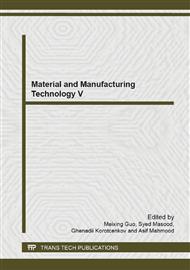p.116
p.121
p.126
p.132
p.136
p.141
p.147
p.152
p.157
Tool Life Study of Coated/Uncoated Carbide Inserts during Turning of Ti6Al4V
Abstract:
For more than three decades, the machining industry has been employing coated tools to enhance productivity via improving tool life. Nonetheless, the problems associated with machining titanium alloys have been still prevalent. Advanced alloy materials such as diamond-like carbon (DLC) coatings are developed to combat these issues. In this study, the performance of a DLC coated tool is assessed and its tool wear mechanisms investigated. For the cutting conditions used during these trials, it has been identified that the DLC coated tool exhibited severe tool wear due to delamination and diffusion in comparison with the uncoated carbide tools. In conclusion, it is suggested that the performance of the DLC coated tools can be enhanced by applying alternate strategies to remove heat from the cutting region.
Info:
Periodical:
Pages:
136-140
Citation:
Online since:
June 2014
Keywords:
Price:
Сopyright:
© 2014 Trans Tech Publications Ltd. All Rights Reserved
Share:
Citation:


